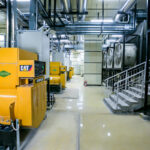Neon lighting has been around for many decades. It was at the peak of its popularity and demand from 1920 to 1960. However, in 1990, LED (light-emitting diode) technology came into existence and it overcame the neon lighting technology with immediate effects. Since then neon lighting technology is unable to gain the attention of the world again, but it is still widely used at restaurants, bars, gas stations, retail outlets, business centers, etc. as neon signs for advertising and branding purposes. They are valuable assets for all types of businesses and services as neon signs help grab people’s attention quickly.
What are Neon Signs?
Neon signs are electrical signs that contain luminous gas-discharge glass tubes. These tubes are sealed, coated, and contain rarefied neon gas and other gasses. The tubes also have electrodes on both ends which function using DC or AC current. When the electricity passes through the gasses present in the tubes, it results in the emission of light. Thus, the neon signs function.
Due to the flexibility and versatility of glass tubes, neon signs can be designed in many shapes, such as alphabets, objects, and gas station price signs, depending on the requirements and preference of the owner. They can be designed for both indoors and outdoors.
Neon signs originally contain only three colors, including red, orange, and a shade of pink. Other gasses, such as argon, krypton, xenon, helium, and mercury vapor, are used for producing other colors.
Components of Neon Signs
Neon signs mainly include five components, including:
Glass Tubes– Soft and flexible glass tubes that typically have a diameter of 8 to 11 mm for indoor signages and 12 to 13 mm for outdoor signs.
Gasses– Neon gas is the primary requirement for neon signs but gasses, such as argon, krypton, xenon, and helium are also required to produce a variety of colors.
Electrodes- Electrodes are pure iron installed at both ends of the glass tube.
Transformer– Neon signs are typically connected to a transformer that helps in increasing the voltage.
Coating– Glass tubes are coated so that high-quality colors can be emitted.
Advantages of Neon Signs
Neon signs give a multitude of advantages to the owner. Some of the most significant advantages include:
Energy-efficient– In terms of energy efficiency, neon signs resemble LED lights. They consume a very low amount of energy to produce high-voltage lights. You can cut down your electricity bill by investing in these lights.
Durable– Neon signs have a long lifespan. If you use them properly, they can last for 3 to 5 years, even more. However, negligence and a careless approach to neon signs can decrease their durability.
Cost-Effective- Neon lights are relatively less expensive. You do not need to empty your pockets to purchase them. If you do not have an idea of purchasing neon signs, it is always a better option to consult with a neon sign repair company.
Super Catchy- Neon signs are not only bright, but they also have that glow and charm that catches people’s attention quickly. With these signs, you can add a huge number of new customers to your business and engage with them for the long run.
Now that you have a basic understanding of neon lights, it is our suggestion to meet a sign and lighting agency before making any decision because they can guide you on what is the best option for you as per your requirements and preferences.






